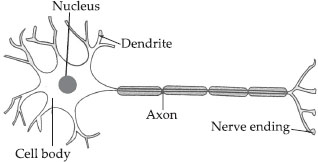Control and Coordination - NCERT Questions
Which of the following is a plant hormone?
| A | insulin |
| B | thyroxine |
| C | oestrogen |
| D | cytokinin |
(d) Cytokinin
Q 2.The gap between two neurons is called a
| A | dendrite |
| B | synapse |
| C | axon |
| D | impulse |
(b) Synapse
Q 3.The brain is responsible for
| A | thinking |
| B | regulating the heart beat |
| C | balancing the body |
| D | all of these. |
(d) All of these
Q 4.What is the function of receptors in our body? Think of situations where receptors do not work properly. What problems are likely to arise?
SOLUTION:The receptors in our body collect information about changes in the environment around us in the form of stimuli. They are located in our sense organs such as the inner ear, nose, tongue, eye, etc. These then pass the information in the form of nerve impulses to central nervous system (spinal cord and brain) where message is interpreted and instructions are sent to effectors which reveal responses. When receptors do not work properly, the environmental stimuli are not able to create nerve impulses and body does not respond.
Q 5.Draw the structure of a neuron and explain its function.
SOLUTION:
Functions–The information acquired at the end of the dendritic tip of a neuron sets off a chemical reaction which creates an electrical impulse. The impulse travels from the dendrite along the axon of its end. At the end of axon, the electrical impulse sets off the release of some chemicals, which cross the synapse and start a similar impulse in a dendrite of the next neuron.

In this way nerve impulses travel in the body. Thus, nervous tissue is made up of an organised network of neurons which are specialised for conducting information via electrical impulse from one part of the body to another.
How does phototropism occur in plants?
SOLUTION:Phototropism is a directional growth which occurs in response to unidirectional exposure to light. Phototropic movement is generally caused by increased auxin on the dark side and lesser auxin on the illuminated side. Due to the presence of more auxin, the part of the plant stem in the dark grows faster, causing it to bend towards the source of light.
Q 7.Which signals will get disrupted in case of a spinal cord injury?
SOLUTION:
The following signals will get disrupted in case of a spinal cord injury:
– Reflex action
– Impulses from various body parts will not be conducted to brain.
– Message from brain will not be conducted to various organs of the body.
How does chemical coordination occur in plants?
SOLUTION:In plants, chemical coordination occurs by plant hormones or phytohormones. Plant hormones are chemical substances other than nutrients, which are produced at specific places in the plant (usually from tips of shoots, roots and branches), and then are diffused to a specific site without translocation to other sites. Phytohormones produce effects like cell multiplication, growth, opening of flowers and regulate physiological processes.
Q 9.What is the need for a system of control and coordination in an organism?
SOLUTION:The body of a multicellular organism consists of a number of components and sub-components and each is specialised to perform a particular function. Therefore, it is necessary that various organs of the body of an organism work together in a proper manner for proper functioning to a stimulus. In human beings nervous system and endocrine system work together for control and coordination.
Q 10.How are involuntary action and reflex action different from each other?
SOLUTION:
Involuntary action
(i) Involuntary action involves autonomic nervous system.
(ii) They occur in response to internal stimuli.
(iii) They are connected with functioning of internal body parts.
(iv) It occurs without the will of the organism. For example, heart beat, breathing, etc.
(v) These are regulated by medulla oblongata (hindbrain).
Reflex action
(i) Reflex action involves all parts of voluntary nervous system though they are not voluntary.
(ii) They operate against harmful stimuli which are generally external.
(iii) They are connected with emergency i.e., response to stimuli.
(iv) Some reflexes involve the brain, rather than the spinal cord.
(v) Reflex is generally controlled by spinal cord.
Name the organism which lacks nervous system.
SOLUTION:Plants lack nervous system.
Q 12.What is the difference between the manner in which movement takes place in a sensitive plant and the movement in our legs?
SOLUTION:
The differences between movement in a sensitive plant and the movement in our legs are given below:
| Movement in a sensitive plant | Movement in legs | |
| 1. | It occurs in response to an external stimulus like touch, pressure or shock. | It occurs voluntarily in response to our need and will. |
| 2. | It is brought about by turgor changes in specific cells. | It is brought about by contraction and relaxation of muscles. |
| 3. | It is controlled by plant hormones. | It is controlled by cerebellum of the hind brain. |